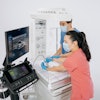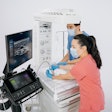
NEW YORK CITY - To detect the most high-grade prostate cancers, it's best to use a combination of contrast-enhanced transrectal ultrasound-guided biopsy and medially directed sextant biopsy, according to a presentation on Monday at the annual American Institute of Ultrasound in Medicine (AIUM) meeting.
In a retrospective review, a team of researchers from Thomas Jefferson University (TJU) found that while laterally directed sextant biopsy was most efficient for overall detection of prostate cancer, the best strategy for detecting high-grade prostate cancers involved both contrast-enhanced transrectal ultrasound-targeted biopsy and medially directed sextant biopsy.
"The optimal combination of biopsies -- if you want to combine systematic and targeted biopsies -- is a combination of targeted biopsies wherever the contrast sends you, plus medially directed cores," said presenter Dr. Ethan Halpern, who shared the group's findings during the morning scientific session at AIUM 2016.
The best biopsy strategy
Contrast-enhanced ultrasound has been found to double the per-biopsy core detection rate in high-grade prostate cancer. However, TJU researchers have previously demonstrated that a targeted biopsy based on contrast-enhanced transrectal ultrasound alone will miss a significant number of prostate cancers that would be detected on systematic biopsy, Halpern said.
"But if we were to do a systematic biopsy on everyone and a targeted biopsy on everyone, that would be 18 cores on every patient, and that's a lot of times to stick someone," he said. "The large number of cores may also result in detection of more indolent cancers, which is something we don't want to do, and is also going to have more morbidity for the patient."
As a result, the TJU researchers set out to define an optimal biopsy strategy that could take advantage of the benefits of contrast-enhanced ultrasound without missing the cancers that are only seen by the systematic cores. They retrospectively evaluated the ultrasound studies of 272 consecutive subjects who had received a 12-core systematic biopsy and contrast-enhanced transrectal ultrasound-targeted biopsy of up to six targeted cores (mean, 4.5 cores per patient) during infusion of the Definity contrast agent (Lantheus Medical Imaging).
The team tabulated the per-patient diagnosis of all prostate cancers and high-grade prostate cancers (Gleason score ≥ 7) for several techniques:
- 12-core systematic biopsy
- Contrast-enhanced transrectal ultrasound-targeted biopsy
- The combination of a laterally directed sextant biopsy of six cores with contrast-enhanced transrectal ultrasound-targeted biopsy
- The combination of a medially directed sextant biopsy of six cores with contrast-enhanced transrectal ultrasound-targeted biopsy
On a by-core basis, a systematic approach detected cancers in 276 (8.5%) of 3,264 cores, compared with 203 (16.4%) of 1,237 targeted cores via contrast-enhanced transrectal ultrasound. The nearly doubling in cancer detection rate was statistically significant (p < 0.001). On a per-patient basis, however, systematic biopsy detected cancer in 105 of the 118 patients with prostate cancer, compared with 71 by contrast-enhanced transrectal ultrasound-targeted biopsy.
"You will miss a substantial percentage of cancers if you just use contrast-enhanced targeted biopsy," Halpern said.
While the combination of contrast-enhanced transrectal ultrasound and a laterally directed sextant (cancer detected in 91 patients) or medially directed sextant (cancer detected in 90 patients) biopsy improved performance, the combinations still had significantly lower overall per-patient cancer detection rates than systematic biopsy (p = 0.04).
"Remember, this includes the population of indolent cancers that we may not even want to detect," he said. "We want to detect the people with higher-volume, higher-grade tumors."
High-grade prostate cancer
When analyzing performance based only on per-patient detection of the 41 patients with high-grade prostate cancer, the researchers surprisingly found that pairing contrast-enhanced transrectal ultrasound-targeted biopsy and a medially directed sextant biopsy performed the best, Halpern said.
| Detection of high-grade prostate cancer | |
| Method | No. of patients |
| Contrast-enhanced transrectal ultrasound-guided biopsy + medially directed sextant biopsy | 40 |
| Contrast-enhanced transrectal ultrasound-guided biopsy + laterally directed sextant biopsy | 37 |
| Systematic 12-core biopsy | 34 |
| Contrast-enhanced transrectal ultrasound-guided biopsy | 30 |
The difference in performance was statistically significant (p = 0.034). Why was that combination the best?
"The reason for this is probably because the medially directed cores are very close to the inner gland, the transition zone," he said. "The transition zone is where all [benign prostatic hyperplasia] happens, and there's a lot of enhancement in the transition zone and it kind of makes it very difficult to pick out what's cancer in the medial aspect of the gland. So we think that perhaps the contrast is not working as well next to the transition zone."




















